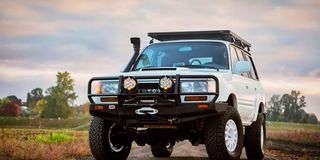4WD snorkels – good for deep water, but that is not their main job

Toyota Landcruiser.
What is the deal with roof-high “snorkels” fitted to 4WD vehicles? Do their owners drive them through water deeper than the bonnet, and can they do that safely and without damage? - Jawa M and others
There are several issues to consider when driving vehicles through water anywhere near “bonnet deep”.
The most serious is that the vehicle will start to float and could be washed away if the water is flowing with any speed. Another is that if the cooling fan is submerged (so it is sucking heavy water instead of light air) its blades could bend forwards and rip the radiator core to shreds.
A third is that the ignition electrics (in petrol cars) could be heavily splashed and the engine will stall. In very deep water traction and power can also be severe challenges.
Snorkels do nothing to prevent or even reduce these risks.
But there is another likely hazard: that deep water will be sucked in by the air intake in the engine compartment, partly starving the engine of air for combustion and potentially causing hydraulic lock (water is sucked into the piston chambers and fills them) which could not only stall the engine but also severely damage it (bent con rods and valve stems among others, as parts moving with very high force and speed are suddenly jammed to a halt – as if they had hit a stone wall).
And that’s a risk that snorkels could do much to prevent because they lift the air intake from just under the bonnet lid inside the engine compartment to the top corner of the windscreen. That’s way out of reach of any depth of water likely to be driven into deliberately. It would be equally effective if it was at least 30cm shorter, even allowing for bow waves and splash.
So the question could be adjusted from “do they work” (yes) and “are they useful” (yes) to is “do they have to go so high?”. And the answer is “Yes”…but not to take them further above deep water in extreme flood conditions. What the extra height does is suck air from further above…the dust! All the time.
Whether dust is almost invisible particles of dirt (which are ever-present, even on tarmac roads) or a choking cloud or blinding blizzard behind a truck driving through lava dust, it exists all the time and it is always doing your engine no good (and shortening the life of your air cleaner).
Dust is very unlikely to cause sudden or catastrophic failure or damage, even for 4WDs regularly using unsurfaced roads, whether ordinarily dusty or super-fine, light and copious lava dust which can be so thick and deep it billows over the bonnet like a burst sack of flour.
All dust is obviously most dense down by the wheels and under the floor; much of it is blown out sideways and a moving vehicle quickly leaves it behind. But lots can billow up into the engine compartment and will be sucked into the air intake, even though it is always mounted as high as possible under the bonnet lid. Where the air is always cleaner, and even heavy dust very rarely reaches, is at and above the top of the windscreen. And that’s where the top of the snorkel draws its breath.
While deep water is most unlikely to reach anywhere near that high, there are rare exceptions. There are tales of diesel 4WDs being towed or winched through water well above bonnet height (with their fans disengaged or… their engines turned off and their under-bonnet air intakes and exhaust pipes taped up, or… wearing a snorkel and using high engine revs to deliver water-repelling exhaust gas pressure).
So while snorkels are usually associated with very wet conditions and floods (and are very rarely necessary for that, even on expeditionary safaris) they actually work all the time, and usefully when conditions are especially dry.





